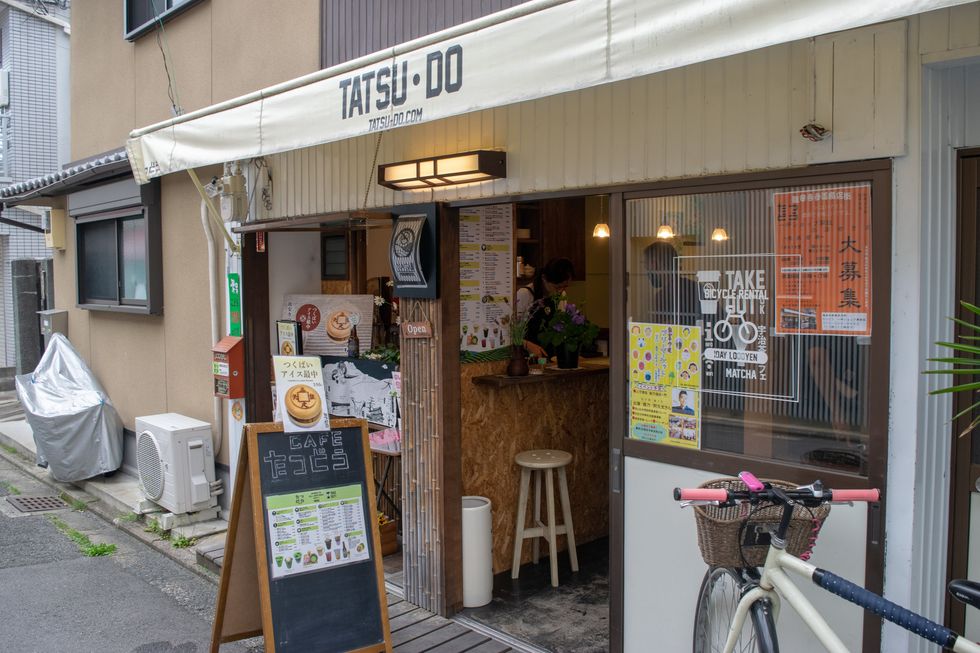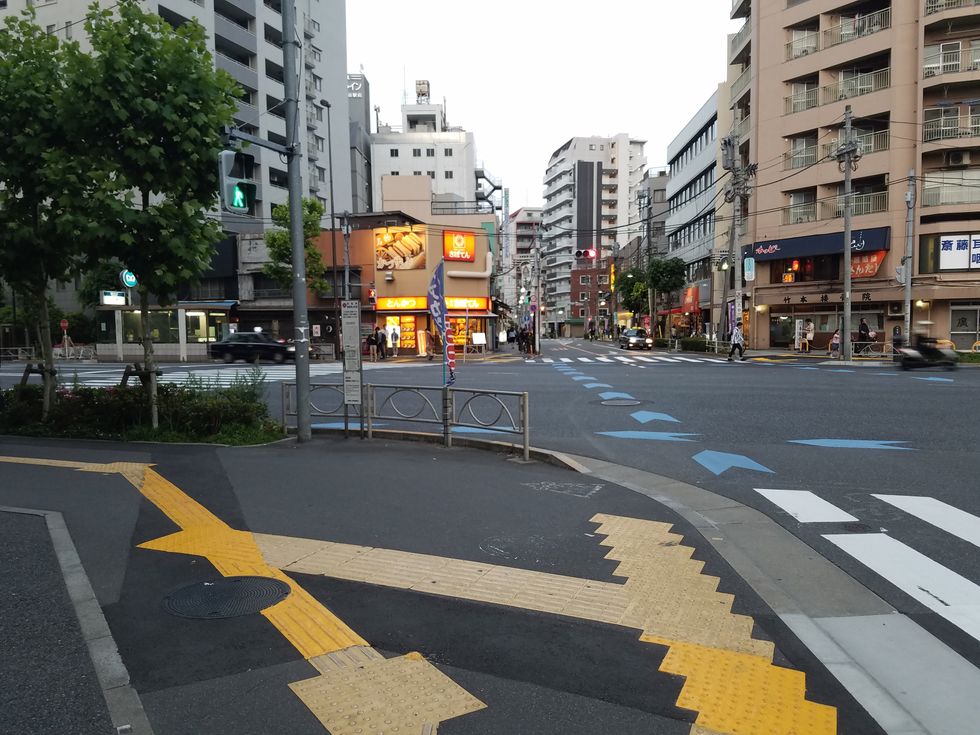The moment the spring semester ended this year, I bounced off to Japan. This was a trip that was conceived in high school with my best friends, and planned in the fall semester. A couple of other friends were added to the roster, and with seven guys in deck, we left on the morning of May 10th to JFK airport. The trip lasted 14 days, with two of them meant for plane travel. We were ecstatic, a bunch of 20 to 21-year-olds with a lot of time, a JR pass, a bunch of cash, and the motivation to explore, and the culture of Japan we were ready to have a blast.
From my point of view, these five aspects to the trip were what made the trip really fun to have.
1. Flexible groups help you visit more in a tight Tokyo
My traveling party in front of the Sensoji Temple.
This is probably more of a large group size phenomenon when traveling, but there’s always going to be multiple ideas and opinions when trying to make a decision. With seven men in our group, it was hard to always come up with day plans or meal locations that we could all agree on. So we already had a mindset on splitting off at certain times, and that helped to make this trip enjoyable as people could visit different things and take a break from one another if needed.
There were times where I walked through Japan alone and it made me feel like I knew what I was doing. I was able to understand the metro system early on (since it was my second time being in Japan) and as long as you don’t have a camera around your neck, the Japanese people mostly treat you less like a tourist and more like a foreigner who is trying to live there. I was able to shop shoes on my own, find a really nice organic cafe, and explore the smaller things that the others probably weren’t interested in completely.
And then there were times where I was in pairs. I’m sure I’ve travelled alone with every person in my group as a pair at least once this trip and even though we are friends there’s a sense of learning from one another when we both have to struggle with some parts of Japan. For example, with a friend named Dylan, we went and visited one of the locations from a famous anime movie named Kimi no na Wa. Or with another friend, Sid, I had some conveyor belt sushi. And the thing is, Tokyo makes it very easy to split off and regroup with one another.
There were many times were we would wait at a station for another friend to come from another part of the city so that we could do something else together. But it’s very hard to do something with all seven of us, and that’s not because we all have different priorities but also because the city is tight. Physically tight. There were times where just four of us filled up half a soup restaurant. Or that the fact that many restaurants have a max of seven seats or so anyway. So the city basically demands small groups. Not that there are things out there that support larger parties, but it’s not commonplace in Tokyo.
2. 20 years old = an adult
Drinks on the Shinkansen, trying to look cool.
One of the best features of Japan was that adults are adults the moment they age into one. They are treated the way an adult would be treated. This is good and bad... bad because we also have to show levels of respect and understanding that are very different from the American standard. But, it mainly good because we all felt like responsible adults there. No one looked at us and thought we were immature or dumb or out of place (other than the fact that we were all non-Japanese people). They treated us with respect and authority that people in America probably wouldn’t have until they get a stable job and look decent. It was a cultural difference that I could get used to.
Also, being an adult means no one gives you warnings. What I mean by that is that, if you were to go into Akihabara (the electric/anime town of Tokyo) you could walk into an anime store like Mandarake and just walk into the adult section by accident and instantly be bombarded with all kinds of media and physical variations of animated and real pornography. Ya, Japanese people are into it and yes I did want to experience Japanese culture, but it’s a sensory overload of a type of attraction to the female body that no one talks about in America, nor do they really want to. And the other customers and the customer associates, they don’t even bat an eye when seeing tourists like us walk in. As long as we’re of age (or appear to be), we’re good. Some places do have a sign that signifies age limits, but it’s just a small 18 symbol with hands in the ‘back off’ gesture.
Another thing is that alcohol is everywhere, and when my friends bought some from the convenience store, the attendant would skip the age check part and just let us buy it. We only got asked for identification once, and that was by a buy the books guy, who didn’t seem to appreciate that we walked into the store at 11 p.m. What I’m trying to say here is that the culture in Japan does have a merge period from child to adult, but it happens when the individual is a teenager. Once they are 20 they are basically just as adult-ish as a 40-year-old. This differs from America because even after we become young adults, we struggle with managing ourselves and being responsible. I felt that difference the moment I entered JFK again at the end of my trip and the customs officer asked me questions in detail as if I wouldn't be able to understand all of what he was asking me for.
3. Everything is written in half-English
One of the many random cafes that spoke little English but was still ready to serve tourists, if you could find them.
This is honestly a blessing to anyone, really. If you can understand pictures, diagrams, and English, then you will be able to get through Japan with ease. Of course, knowing a bit of Japanese will help as the locals will appreciate your effort to learn their ways and also help you get across certain points where English/diagrams aren't present. But in most cases, there are various ways for people who don't know Japanese to get across.
For example, when driving (if you get an International Driver's Permit like me for only $20), all signs on the road are clear in their shape and color or if they have words, then the words are in Japanese and in English. Or another example was when we went to a Japanese izakaya, they pulled out an English menu even though they couldn't actually speak English themselves. Pointing works best in this case scenario. A little side note about English in Japan, usually older people don't speak English. Partly because they have a dedication to Japanese and partly because they weren't taught English in school back in their day. So if you ever need help, look around for a high school student or a younger adult... especially if they seem like a business person or a salaryman/woman.
Here's the thing though, when asking people try to imitate their accent. It seems to help because when you speak in fluent English, it tends to go over their head and that was a mistake a few members in our group did. Also body language and gestures help so much in getting a point across. Now, this point doesn't work everywhere though. In Akihabara, there was a hidden store that sold old used electronics like film cameras, watches, radios, walkmans and the sort and the people there did not speak English at all with no signs around either. That was where my 1.5 semesters in Japanese kicked in and helped me purchase the 35mm camera I wanted to buy (for only ~$25!).
Or if you go outward from touristy areas, the commonality of English decreases, but diagrams tend to be everywhere regardless. There were places in Tokyo that are very western as well, like Harajuku or Shibuya and there shouldn't be an issue with language there. Even the metro is in multiple languages (Japanese, Chinese, Korean, and English) so all you have to do is understand the way the subway works. Just try to understand what the diagrams mean and use a bit of common sense and you'll have little issue.
4. Thinking from the bottom up
See those yellow lines? They hurt to walk on, but they have a crucial purpose.
There was a sense of amazement to me, and at one point, I had left the train station I was at and walked a few steps in the wrong way before looking at Google Maps and walking the other way. Google Maps wanted me to go around the building that the station was under, but my friend pointed out that the station exit had another exit on the other side of the building, like the building made a hole in itself so you can walk right through it. And I said, "that's convenient." But he said it was efficient. And that happened a lot during my trip. A lot of things seem so convenient, and it's done with efficiency in mind.
I felt that the Japanese have the mindset of perfecting the little things and the bigger things will fall into place too. Like, at a restaurant, a wrapped moist paper towel is given to you for your meal. And it makes sense because napkins can only clean so much, and Japanese food can be sticky so a moist napkin is what you really need. Another thing is the social rule that eating/drinking while walking is forbidden. This may seem annoying but it's done to minimize litter on the ground, and it works because you barely see any litter in Tokyo.
Garbage cans are also the hardest things to find, but if you find a vending machine or a convenience store, there is bound to be a garbage can there as well. Since there are vending machines and convenience stores on almost every block in Tokyo, litter is minimized as well. When talking about these convenience stores, oh boy, they are so well stocked that I wish our Wawa's and 7-Eleven's were like this. The 7-Eleven in Japan can have anything from magazines, emergency shirts/pantyhose, deo, drinks, alcohol, snacks, ice cream, cigarettes, and even packaged lunch/dinner (and they'll heat it for you too.)
I really liked that the metro lines were named after the district in the middle of the line. So if you wanted to go to Ueno, and you're in Ikebukoro. And you know that Ginza is close to Ueno and in between you and Ueno, and you know that the last stop on the Ginza Line is Asakusa, which is next to Ueno; you can just take the Ginza Line and probably end up near where you want to go. Of course that means you know the city, but this was something I picked up during my 12 days there, and it helped me when I had to catch the last train back to my Airbnb from Ikebukuro when my phone ran out of battery (I got close, but missed the last train transfer to where I was staying and had to pay for a taxi.) I'm not so sure you can do that type of thinking with the NYC subway.
One of the things that Japan has down perfect though is customer service, it starts with the many welcomes you get from all the employees to numerous amounts of thank yous you get when leaving the store or restaurant. Even if you don't buy anything there, treating the customer right makes the environment so pleasurable and attracts other customers in. And it makes people happy, which is good in a bustling city. One more thing, when walking around in Tokyo you will notice a yellow dotted line on the sidewalks and in the stations. We didn't know what it was, but when we found out it was surprising. The very bumpy and annoying yellow path was meant for vision impaired individuals so they could feel their way with their feet (these bumps are hard enough to feel through your shoes) and navigate themselves to where they need to go. I can't believe Japan had thought about that.
5. Japan is naturally aesthetic
Me in residential Harajuku. You don't understand, we have more than 200 images of just Japanese roads and alleyways.
I really love it when people take the time to consider how something looks in addition to the function it has. So walking on the roads on Japan was amazing. I would look down so many alleyways for blocks upon blocks and it was beautiful. And yes, I understand that these are just roads or just part of the city. So the locals were puzzled a little when one of us would find a certain part of the road interesting and take a picture of it. And they would look at it and just be like, "what's there to see?" To them, clearly, it's just part of the city they were raised in. But for us it was part of the sightseeing. To see such tight roads with paved asphalt, meant only for bikes and pedestrians, with random shrubbery and the absence of litter. That was something fascinating for us. You don't see that everywhere. So even though there's decay, or a bunch of electric wires in the way, it was something different from what we were used to.
There is also the fact that if you watch anime, particularly from the '90s, a lot of Tokyo will remind you of them. The old mixed in with the new or a somewhat neat and tidy mess. Like, we once saw this house that was squeezed in between multiple others, that's not the interesting part. The interesting part was that the main door was like a garage door and it had windows so you could see inside. Inside was bunches of newspapers and a small desk in the corner with a lamp. And in the center of that room was the owner's car. Just tucked in, fitting perfectly. This might be normal, but it was wild to us. If anyone has seen Kimi no na Wa, the last scene takes place on a staircase with red railings. We went there and looked at it. It's literally just four flights of stairs with an extremely linear road at the bottom of it and a packed residential area at the top of it. And if it wasn't for the movie, this staircase might not even be noticed by the locals. In fact, while we were taking our photos there people were simply using it for what it was meant for. To get to the top, like one lady was just going home after grocery shopping and had to use these stairs. But it was aesthetic. And that's what I loved, that these people live in a world of aesthetic and it's all just commonplace for them because they all agreed on a culture that seeks efficiency but also seeks presentability.
























